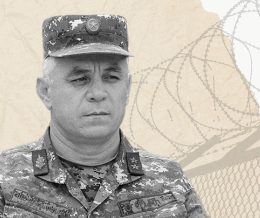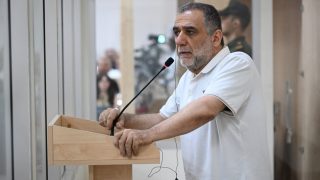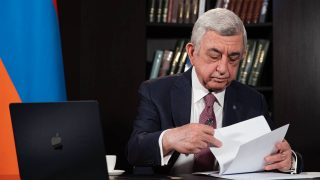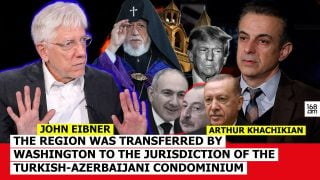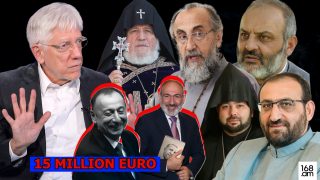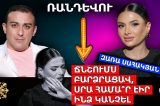
Nagorno-Karabakh’s Right to Self-Determination Putting it on the Agenda
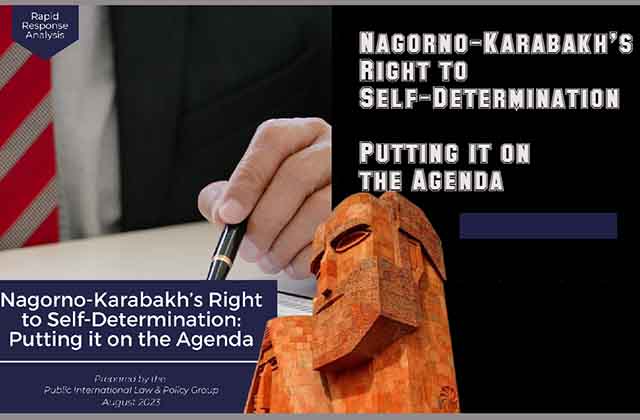
Statement of Purpose
The purpose of this memorandum is to set forth the argument that the Armenian people of Nagorno-Karabakh are entitled, at a minimum, to the right of internal self-determination and that the current negotiations should provide for the meaningful and effective protection of this right. As such, Nagorno-Karabakh’s Soviet era autonomous status shall serve as a benchmark for discussions between Armenia and Azerbaijan concerning the future fate and status of the people of Nagorno-Karabakh.
For clarification, this memorandum shall not be construed as advocating a specific outcome to the talks between Armenia and Azerbaijan. That is within the purview of the negotiating parties to determine, and first and foremost, for the people of Nagorno-Karabakh.
Executive Summary
At the moment there are ongoing negotiations hosted on one side by the European Union and the United States and on the other by Russia to resolve the conflict between Armenia and Nagorno-Karabakh with Azerbaijan.
The agenda for the talks currently includes: 1) border delimitation; 2) unblocking transport and economic links; 3) ending the Azerbaijani siege of Nagorno-Karabakh; 4) releasing detainees and prisoners of war and addressing missing persons; and 5) security and rights of the population of Nagorno Karabakh.
To craft a durable peace, consistent with international human rights principles, the agenda must include the right of the people of Nagorno-Karabakh, to self-determination. The bare discussions of the latter’s “security and rights” outside the context and framework of their right to self-determination as envisaged in the current agenda, will have no value and will be illusive. The meaningful discussion of those existential issues can occur only in the context of the realization of the inherent right of the people of Nagorno Karabakh to self- determination.
The principle of self-determination is clearly set forth in the United Nations Charter, numerous General Assembly resolutions, and international treaties, and reaffirmed in various International Court of Justice decisions, as well as by regional and domestic courts.
The principle of self-determination can be exercised internally, through autonomy within the contours of a larger state, or externally, by creating a new state. While different views remain on whether external self-determination includes remedial secession, there exists no controversy that internal form of self- determination applies to all peoples.
For a group to be entitled to a right to collectively determine its political destiny, it must possess a focus of identity sufficient for it to attain distinctiveness as a people.¹ The Armenians of Nagorno-Karabakh possess the objective and subjective factors required of a group entitled to the right to self-determination.²
For centuries the Armenian people of Nagorno-Karabakh have maintained a coherent identity as a people with an attachment to the land of Nagorno-Karabakh. While politically infringed upon at times, this territory has possessed the status of Nagorno-Karabakh Autonomous Oblast during the Soviet times, and maintained an effective and legitimate government over the territory since the dissolution of the Soviet Union.
In November 1991, the Supreme Soviet of Azerbaijan adopted a resolution on the “Abolition of the Nagorno-Karabakh Autonomous Oblast.” Azerbaijani President A. Mutalibov then signed the law on dissolution of the Nagorno- Karabakh Autonomous Region on November 23, 1991. More recently, Azerbaijan’s current president Ilham Aliyev has publicly declared that “zero status” will be granted to the people of Nagorno Karabakh.
Azerbaijan has a long history of denying Armenians their right to self- determination, and all indications are that without comprehensive and effective mechanisms negotiated under the auspices of the international community with substantial enforcement mechanisms, not only will this right be denied, but the Armenian people of Nagorno-Karabakh will continue to be subject to gross human rights violations, including ethnic cleansing and forced deportation.
Azerbaijan’s refusal to include on the agenda of the ongoing talks Nagorno- Karabakh’s Soviet era autonomous status as a benchmark for the right of the people of Nagorno Karabakh to self-determination and for discussions between Armenia and Azerbaijan concerning their future fate and status, will be a clear signal of a continued rejection of that right for the people of Nagorno-Karabakh, and this opens the door to the possibility of external self-determination via remedial secession.
Brief History of the Conflict
Before Sovietization
Nagorno-Karabakh is historic Armenian territory which, in different eras, has formed part of Armenia. Its Armenian roots reach back to before the first millennium BC. Armenian princely dynasties successively presided over Karabakh, guaranteeing its sovereignty through treaty arrangements with neighboring powers.
The Russian Empire, expanding southwards in the Transcaucasus, annexed Karabakh in 1805. This action was officially recognized by Persia in the Treaty of Gulistan in 1813. After the 1917 Russian revolutions and the collapse of Tsarist rule, there emerged in 1918 the briefly independent Republics of Armenia and Azerbaijan. The dispute over Nagorno-Karabakh between the Karabakh Armenians and Azerbaijan, on whose side the Ottoman Turkish army intervened, dates from this period.
In July 1918, the First Armenian Assembly of Nagorno-Karabakh declared the region self- governing and created a National Council and government. The size of Nagorno-Karabakh was then significantly greater than the portion that subsequently became the Nagorno-Karabakh Autonomous Oblast. In August 1919, the Karabakh National Council entered into a provisional treaty agreement with the Azerbaijani government. Despite signing the Agreement, the Azerbaijani government continuously violated the terms of the treaty. This culminated in March 1920 with the Azerbaijanis’ massacre of Armenians in Karabakh’s former capital, Shushi, in which it is estimated that more than 20,000 Armenians were killed. In this light, the Ninth Karabakh Assembly nullified the treaty in whole and pronounced union with Armenia.
From 1918 to 1920 Nagorno-Karabakh possessed all necessary attributes of statehood, including an army and legitimate authorities. The League of Nations and the leading world powers recognized the disputed status of Nagorno-Karabakh. The League of Nations neither recognized the sovereignty of the Azerbaijan Republic over Karabakh nor accepted the Azerbaijan Republic as its member-state.
In 1918, 330,000 Armenian people lived within the then-existing borders of Nagorno-Karabakh. They made up 95 percent of its population, with 3 percent Azerbaijanis and 2 percent others. As a result of the Turkish-Azerbaijani aggression in 1918-1920 aimed at total cleansing of the Armenians of Nagorno- Karabakh, an estimated 20 percent of all Armenians were killed.
Nagorno-Karabakh Under Soviet Azerbaijani Rule: 1920-1988
The violent conflict in the Caucasus ended with the Sovietization of the Caucasian republics. On November 30, 1920 the Sovietized government of Azerbaijan recognized Nagorno-Karabakh as a part of Armenia, but then reversed this decision several days later.
On March 16, 1921, a treaty between Turkey and Soviet Russia determined that Nagorno-Karabakh and Nakhichevan were to be under the authority of Soviet Azerbaijan. On June 12, 1921 the government of Soviet Armenia declared Nagorno-Karabakh as its integral part on the basis of the repeatedly expressed will of its population.
On July 5, 1921 the Caucasus Bureau of the Russian Communist Party adopted a political decision to annex Armenian-populated Nagorno-Karabakh to Soviet Azerbaijan, thus laying the foundation for the Stalinist practice of gerrymandering in Transcaucasia. Stalin decided that Nagorno-Karabakh should be included as an autonomous region within the boundaries of the Soviet Republic of Azerbaijan, in consideration of the necessity of national harmony between Muslims and Armenians, of the economic tie between Upper and Lower Karabakh, and its permanent relationship with Azerbaijan.
In 1923, Nagorno-Karabakh had a population of almost 158,000, 95 percent of which were Armenians. On July 7, 1923, Soviet Azerbaijan’s Revolutionary Committee resolved to dismember Karabakh and to create on part of its territory the Autonomous Region (oblast) of Nagorno-Karabakh. From 1924 to 1929, an uncertain jurisdiction called “Red Kurdistan” was established, with the intent of effectively separating Nagorno-Karabakh from Armenia. In 1930, the Kurdish autonomous area was abolished, but the artificial buffer between Armenia and Karabakh, the Lachin and Kelbajar districts (regions), was retained. Stalin’s 1936 Constitution sealed this territorial arrangement.
This separation became a subject of continual protest from both Nagorno- Karabakh and Armenia — which was expressed periodically in the form of petitions to Moscow. Furthermore, in September 1966, the Soviet Armenian leadership petitioned the central authorities to examine the question of returning Karabakh to Armenia. In addition to the petitions, by the late 1960s there were mass protests held in Karabakh, which led to a large-scale crackdown on Armenian activists.
1988 to the Present
The current struggle over Nagorno-Karabakh began in February of 1988 when the Karabakh Armenians, encouraged by perestroika and glasnost, began to take steps to break free of Azerbaijani control. On February 20, 1988, the Decision of the Nagorno-Karabakh Autonomous Oblast (NKAO) Regional Soviet of People’s Deputies, which was addressed to the highest legislative bodies of the Supreme Soviets of Armenia, Azerbaijan, and the USSR, contained the official request to consider and resolve positively “the question of handing over the NKAO from the Soviet Azerbaijan to the Soviet Armenia.”
The response within Azerbaijan was brutal acts of violence organized by Azerbaijani nationalists with the tacit support of the secret police directed against the Armenian civilian population. On February 26, 1988, the international community witnessed the massacre of Armenians in Sumgait, the third largest city of Azerbaijan and its second largest industrial center. Individual Armenians were attacked in their homes, at their businesses and on the streets. Azerbaijani authorities exerted no effort to apprehend or prosecute the perpetrators.
On June 13, 1988, the Supreme Soviet of the Azerbaijani SSR denied the application of the Karabakh Assembly. This was counterbalanced on June 15 by Armenia’s Supreme Soviet, which approved Karabakh’s request and appealed to the Soviet government to resolve the matter.
On July 18, 1988, the USSR Supreme Soviet, relying on Article 78 of the Soviet Constitution, which prohibited any territorial changes to a Union republic without its consent, decided to leave Nagorno-Karabakh within the structure of Soviet Azerbaijan. However, by the March 24, 1988, resolution of the Central Committee of the Communist Party of the Soviet Union Arkadi Volsky was appointed Moscow’s authorized representative in the territory. Beginning on January 20, 1989, the Supreme Soviet established a special authority in Nagorno- Karabakh, headed by Volsky, which was directly subject to the USSR government. In the summer of 1989 a legislative body, named the National Council was formed which represented all strata of the Nagorno-Karabakh population.
The USSR Supreme Soviet’s resolution of November 28, 1989, liquidated the “Volsky Committee.” Three days later, on December 1, 1989, at the joint session of Parliaments of Armenia and Nagorno-Karabakh the reunification was accepted. Soon after, the NKAO legislative body voted in favor of secession from Azerbaijan. The Supreme Soviet of Azerbaijan quickly rejected the decision as illegal, and the Presidium of the Supreme Soviet of the Union declared it null and void.
In 1989, according to the official USSR census, Nagorno-Karabakh had 189,000 inhabitants, of whom 76.9 percent were Armenians and 21.5 percent were Azerbaijanis.
On January 15, 1990, a USSR Supreme Soviet decision installed Soviet Azerbaijan’s “Republic Organizational Committee” (Orgkom). The stated purpose of this body was to reestablish the erstwhile local “soviets” of Nagorno-Karabakh. In reality, though, the Committee, under the direction of Azerbaijani Communist Party deputy leader Viktor Polianichko, schemed to do away with Karabakh’s autonomy. Polianichko aimed to resolve the issue by ridding Karabakh of its Armenian majority. Therefore, he artificially increased the size of the Azerbaijani community in Nagorno-Karabakh. This was combined with concerted military actions. From January to May 1991, the inhabitants of 24 Armenian villages in Nagorno-Karabakh were forcibly driven from their homes. As a consequence Soviet Azerbaijan placed more than half of Nagorno-Karabakh’s territory under military occupation.
On August 30, 1991, Soviet Azerbaijan’s Supreme Soviet adopted its “Declaration on re-establishment of the national independence of the Azerbaijani Republic.” Four days later Nagorno-Karabakh initiated the same process through the joint adoption of the “Declaration of the Republic of Nagorno-Karabakh” by the local legislative councils of Nagorno-Karabakh and the bordering Armenian- populated Shahumyan district. The only difference was that, for Karabakh, independence was declared not from the Soviet Union but from Azerbaijan. This act fully complied with existing law. Indeed, the 1990 Soviet law titled “Law of the USSR Concerning the Procedure of Secession of a Soviet Republic from the USSR,” provides that the secession of a Soviet republic from the body of the USSR allows an autonomous region and compactly settled minority regions in the same republic’s territory also to trigger its own process of independence.³
On October 18, 1991, the Azerbaijani Republic confirmed its own independence by adoption of its “Constitutional Act” on national independence, and in November the Supreme Soviet of Azerbaijan adopted a resolution on the “Abolition of the Nagorno-Karabakh Autonomous Oblast.” Azerbaijani President A. Mutalibov then signed the law on dissolution of the Nagorno-Karabakh Autonomous Region on November 23, 1991.
Following the adoption of this resolution, the Azerbaijani parliament redrew Nagorno-Karabakh’s borders in favor of neighboring Azerbaijani districts, and changed the names of its cities and villages. In so doing, Baku flouted Articles 86 and 87 of the Soviet Constitution, which codified autonomous region status for Nagorno-Karabakh and prohibited any change therein without its consent, and also violated its own law. This decision was designed to prevent Nagorno-Karabakh from using the relevant articles of Soviet law to legally separate from Azerbaijan, as well as a way to more directly manipulate Karabakh’s demography through territorial gerrymandering, forced depopulation and resettlement.
On November 27, 1991, the USSR Constitutional Oversight Committee’s resolution deemed unconstitutional the Orgkom created by the Supreme Soviet decision of January 15, 1990, as well as the November 23, 1991 Azerbaijani decision abolishing Karabakh’s autonomy. It also revoked the December 1, 1989, Armenian resolution on reunification.
The actions of the USSR Constitutional Oversight Committee did not, however, annul the joint decision of the NKAO and Shahumyan district to declare the establishment of the Nagorno-Karabakh Republic on September 2, 1991, since that declaration was deemed in compliance with the then existing law. (The April 3, 1990 “Law of the USSR Concerning the Procedure of Secession of a Soviet Republic from the USSR,” provides autonomous entities and compactly settled ethnic minorities living in a seceding republic’s territory with the right of self- determination, to be confirmed with a referendum. The Nagorno-Karabakh Republic was proclaimed on the basis of the referendum provided under this law by the NKAO and Shahumyan district after the announcement of Azerbaijan’s independence on August 30, 1991.)
On December 10, 1991, the Nagorno-Karabakh Republic held its own referendum on independence in the presence of international observers. The vote overwhelmingly approved Karabakh’s sovereignty. This action of Nagorno- Karabakh, which at that time was part of a still existent and internationally recognized Soviet Union, corresponded fully with the relevant Soviet law pertaining to leaving the USSR. As an initial step along the path to full sovereignty, the newly independent Nagorno-Karabakh Republic created legitimate government institutions. On December 28, 1991, elections took place for its parliament, and on January 6, 1992, the newly convened parliament of Karabakh adopted its Declaration of Independence on the basis of the referendum results.
The reaction from Azerbaijan, which physically surrounded Karabakh and its capital, Stepanakert, was to commence a campaign of indiscriminate bombardment and shelling of the Karabakh Armenians and to launch a series of ground attacks. Azerbaijani attacks commenced in early 1991, with mass bombardment of Stepanakert and other towns and villages. By the summer of 1992, Azerbaijan had seized and occupied about half the territory of the Nagorno- Karabakh Republic and forcibly dislocated and displaced the Armenian inhabitants.
The Karabakh Armenians organized an army and undertook military operations which allowed them to seize Azerbaijani-held areas used to launch attacks on Stepanakert and nearby towns, and to break the Azerbaijani-imposed blockade of Karabakh by establishing a ground connection to Armenia.
On May 8, 1992, the Karabakh Defense Forces took the strategically important town of Shushi, from which the Azerbaijanis had been shelling Stepanakert. On May 18, they established a land link with Armenia across the Lachin region, thus breaking the blockade on Karabakh. In the summer of 1992 Azerbaijan occupied approximately 60% of the territory of Nagorno-Karabakh and displaced the population.
Facing continuing efforts by the Azerbaijani forces aimed at the destruction of the Karabakh Armenians, Nagorno-Karabakh reached out to the international community. It then prepared for a limited counteroffensive to secure for its inhabitants some level of safety. At the same time, Nagorno-Karabakh moved ahead with establishing itself as a functioning democracy in the region.
On September 20, 1992, the Nagorno-Karabakh parliament petitioned the United Nations, the Commonwealth of Independent States, and individual countries for recognition of the Nagorno-Karabakh Republic.
On March 27, 1993, the Karabakh Defense Forces, responding to an Azerbaijani spring offensive, launched counter attacks at two strategic Azerbaijani cities, Kelbajar and Fizuli. The capture of Kelbajar on April 3 freed Karabakh from Azerbaijani attacks on its North and West. From July 23 to September 4, 1993, Karabakh Defense Forces took control of Agdam, Fizuli, Jebrail, and Horadiz, in order to acquire sufficient territory to create a buffer zone for civilians against any indiscriminate attacks of the Azerbaijani army. From December 22, 1993, to May 1994, the re-formed Azerbaijani army launched new unsuccessful attacks on Karabakh.
At this time, Azerbaijan continues to occupy all of the Shahumyan district, as well as parts of the Martakert and Martuni districts of the Nagorno-Karabakh Republic, while the latter controls parts of Azerbaijan seized for defensive purposes.
Following a negotiated cease-fire, Nagorno-Karabakh set about demonstrating to the international community its ability to maintain and promote highly developed governmental institutions, political parties, and free local and parliamentary elections. On December 28, 1994, the Nagorno-Karabakh Parliament adopted a resolution establishing the post of President of the republic. In the presence of international observers the legislature elected Robert Kocharyan president pro- tempore. Two years later, on November 24, 1996, national elections were held and Robert Kocharyan was reelected president by popular vote, with the presence of international observers. After Robert Kocharyan accepted the position of Prime Minister of Armenia, new Presidential elections were held in August 1997, with former Foreign Minister Arkady Ghoukasyan elected for a five year term.
From 1997 to the present Nagorno-Karabakh has held regularly scheduled free and fair elections and has functioned as a modern democratic political entity, with regular peaceful transitions of government.
On November 29, 2007 the Co-Chairs of the OSCE Minsk Group issued a set of Basic Principles for the Peaceful Settlement of the Nagorno-Karabakh conflict, referred to as the Madrid Principles. The Co-Chairs indicated that these principles represented their assessment of the best possible path towards resolving the conflict. The Principles provided in part that:
1. The final legal status of Nagorno-Karabakh will be determined through a plebiscite allowing the free and genuine expression of the will of the population of Nagorno-Karabakh.
2. During the interim period until the determination of the final legal status of NK, its inhabitants will enjoy certain rights and privileges.
3. All the Azerbaijani territories around Nagorno-Karabakh under Armenian control will be returned to Azerbaijan’s control.
4. A corridor of an agreed width will link Nagorno-Karabakh to Armenia.
5. All internally displaced persons and refugees from the conflict- affected areas will have a right to return on a voluntary basis, as soon as the Office of the U.N. High Commissioner for Refugees has determined that conditions are appropriate, in the places of their former residence.
With respect to principle number 2, the Madrid Principles specifically provided:
● The inhabitants of Nagorno-Karabakh will have the right to protect and control their political and economic viability and security within a democratic society committed to the rule of law. Their human rights and fundamental freedoms will be respected.
● The inhabitants of Nagorno-Karabakh will have the right to elect officials to govern Nagorno-Karabakh during the interim period. These officials will exercise legislative and executive power over the internal affairs of Nagorno-Karabakh, as well as provide for the establishment and maintenance of courts of law to administer justice. These officials will also be able to engage in external relations in those areas specified in the Peace Agreement.
● The interim authorities of Nagorno-Karabakh will be allowed observer status in the OSCE for those sessions in which issues directly related to Nagorno-Karabakh are discussed. They will also have the right to seek membership in international organizations for which statehood is not a precondition.
● The inhabitants of Nagorno-Karabakh will be entitled to receive aid from foreign countries and international donor organizations provided that such aid is intended to promote human rights, peaceful economic and democratic development, cultural and commercial ties or to meet basic humanitarian needs. They will also be able to seek foreign direct investment and access to international markets.
The Presidents of Armenia and Azerbaijan did not sign the principles as requested, but the principles continued to be considered as the legitimate basis for a negotiated settlement. The Principles were reaffirmed in 2009 by the Presidents of France, Russia and the United States at the G8 summit in L’Aquila Italy.
In 2020 a 44 day war broke out between Azerbaijan, Nagorno-Karabakh and Armenia. As a consequence of the conflict Azerbaijan assumed control of the territory surrounding Nagorno-Karabakh as well as some territory of Nagorno- Karabakh proper. In November of 2020 Russia mediated a ceasefire which provided for the return of the Agdam, Kalbajar, and Lachin to Azerbaijan (excluding the Lachin corridor, which connects Armenia to Stepanakert, the capital of Nagorno-Karabakh). Russian peacekeeping troops were deployed to ensure the terms of the ceasefire.
In December of 2022 Azerbaijan instituted a blockade of Nagorno-Karabakh by closing the Lachin corridor. The International Court of Justice in February of 2023 acted on the request of Armenia for provisional measures and ordered Azerbaijan to lift the blockade and take all measures at its disposal to ensure unimpeded movement of persons, vehicles and cargo along the Lachin Corridor in both directions. Azerbaijan has failed to comply with this order.
The Right of Self-Determination
Under the principle of self-determination, all self-identified groups with a coherent identity and connection to a defined territory are entitled to collectively determine their political destiny in a democratic fashion and to be free from systematic persecution.
International Recognition of the Principle of Self-Determination
The principle of self-determination is clearly set forth in the United Nations Charter, numerous General Assembly resolutions, and international treaties, and reaffirmed in various International Court of Justice decisions, as well as by regional and domestic courts. Moreover, the principle of self-determination is part of customary international law and thus binding on all states.
The principle of self-determination is included in the United Nations Charter. Specifically,
Article 1 (2): To develop friendly relations among nations based on respect for the principle of equal rights and self-determination of peoples, and to take other appropriate measures to strengthen universal peace;
Article 55: With a view to the creation of conditions of stability and well- being which are necessary for peaceful and friendly relations among nations based on respect for the principle of equal rights and self-determination of peoples, the United Nations shall promote:
a. higher standards of living, full employment, and conditions of economic and social progress and development;
b. solutions of international economic, social, health, and related problems; and international cultural and educational cooperation; and
c. universal respect for, and observance of, human rights and fundamental freedoms for all without distinction as to race, sex, language, or religion.
The right to self-determination has also been repeatedly recognized in a series of resolutions adopted by the U.N. General Assembly, the most important of which is Resolution 2625(XXV) approving the United Nations’ 1970 Declaration on Principles of International Law Concerning Friendly Relations.⁴
The declaration sets froth that:
By virtue of the principle of equal rights and self-determination of peoples enshrined in the Charter of the United Nations, all peoples have the right freely to determine, without external interference, their political status and to pursue their economic, social and cultural development, and every State has the duty to respect this right in accordance with the provisions of the Charter.
In the Western Sahara case in 1975,⁵ the Frontier Dispute case in 1986,⁶ and the Case Concerning East Timor in 1995, the International Court of Justice held that the principle of self-determination has crystallized into a rule of customary international law, applicable to and binding on all States.⁷
The principle of self-determination was further codified in the International Covenant on Civil and Political Rights, and the International Covenant on Economic, Social and Cultural Rights — which are considered to constitute the international “Bill of Rights.”⁸
Article 1, common to both the International Covenant on Economic, Social and Cultural Rights and the International Covenant on Civil and Political Rights reads:
1. All peoples have the right of self-determination. By virtue of that right they freely determine their political status and freely pursue their economic, social and cultural development;
2. The States Parties to the present Covenant … shall promote the realization of the right of self- determination, and shall respect that right, in conformity with the provisions of the Charter of the United Nations.⁹
Before its break up, the Soviet Union was a party to both of these human rights treaties, and the U.N. Human Rights Commission confirmed in 1993 that the former Soviet Republics continue to be bound by these treaty obligations.¹⁰
Moreover, in accordance with the Charter on European Security accepted by the OSCE in Istanbul in November 1999, it is now widely held that conflict concerning ethnic minorities can only be positively resolved within democratic entities, and that in instances where states are undemocratic the principle of self- determination takes greater priority over the principle of territorial integrity.
The principle of self-determination can be exercised internally, through autonomy within the contours of a larger state, or externally, by creating a new state. According to the ICJ decision in Chagos, while external self-determination can be materialized in cases of decolonization and alien subjugation “the right to self-determination, as a fundamental human right, has a broad scope of application”.¹¹ The latter suggests that external self-determination may also include remedial secession in cases of systemic oppression. This argument has been proposed also by a number of domestic and international courts and committees. While different views remain on whether external self-determination includes remedial secession, there exists no controversy that internal form of self- determination applies to all peoples.
This type of internal self-determination has been recognized by judicial bodies and national courts. In 1920, a Commission of Rapporteurs, operating within the auspices of the League of Nations, recognized that the people of Aaland Islands, which belonged to Finland but claimed the right to separate from Finland in order to join Sweden, had the right to exercise self-determination through internal autonomy within Finland. The Canadian Supreme Court, in its advisory opinion regarding the legality of the proposed Quebecois secession from Canada, expressed a similar view in 1998 and held that peoples had the right to exercise self-determination through the pursuit of their “political, economic, social and cultural development within the framework of an existing state.”
Moreover, the Canadian Supreme Court held that “the general state of international law with respect to the right of self-determination is that the right operates within the overriding protection granted to the territorial integrity of ‘parent’ states.” Within the context of the break-up of the former Yugoslavia, the Badinter Commission, a body of experts appointed by the European Community to address complex international law issues related to the country’s dissolution, also confirmed that international law principle of self-determination “must not involve changes to existing frontiers at the time of independence,” thereby implicitly affirming that peoples hold the right to internal self-determination, which can be exercised through autonomy within the contours of an existing state. Thus, in light of the above-described international law instruments and court decisions, the right to internal self-determination attaches to all peoples.
Qualifying for the Right Self-Determination
For a group to be entitled to a right to collectively determine its political destiny, it must possess a focus of identity sufficient for it to attain distinctiveness as a people.¹²
The traditional two-part test examines first “objective” elements of the group to ascertain the extent to which its members share a common racial background, ethnicity, language, religion, history, and cultural heritage. Another important “objective” factor is the territorial integrity of the area which the group is claiming.¹³
The second “subjective prong” of the test requires an examination of the extent to which individuals within the group self-consciously perceive themselves collectively as a distinct “people.” It necessitates that a community explicitly express a shared sense of values and a common goal for its future. Another “subjective” factor is the degree to which the group can form a viable political entity.¹⁴
The Armenians of Nagorno-Karabakh are a Group Entitled to Self- Determination
The Armenians of Nagorno-Karabakh possess the objective and subjective factors required of a group entitled to the right to self-determination.¹⁵
The Armenians of Nagorno-Karabakh are objectively distinct from the Azerbaijanis. The Nagorno-Karabakh Armenians speak a dialect of Armenian, an Indo-European language, while the Azerbaijanis speak a Turkic dialect, which is part of the Altaic language group. The Nagorno-Karabakh Armenians are Christians, while the Azerbaijanis are predominantly Shia Muslims. And the Nagorno-Karabakh Armenians share the ancient culture and historical experience of the Armenian people, while the Azerbaijanis are now developing a national identity and share the historical experience of Turkic peoples.
Nagorno-Karabakh also has a long tradition of being a distinct territorial unit. The region of Nagorno-Karabakh (Artsakh) was organized as one of the fifteen provinces of historical Armenia and was also a separate “Melikdom” under the Persian Empire. Nagorno-Karabakh’s distinct territorial identity was recognized by the Soviet Union when it was designated an “autonomous region” (1923 through 1989) and later as an “ethno-territorial administrative division” administered directly from Moscow rather than by Azerbaijan (January through November 1989).
With respect to the subjective prong of the test, the Armenian population of Nagorno-Karabakh responded to the decision of Azerbaijan to remove the autonomy of Nagorno-Karabakh and to place the region under Azerbaijan’s direct administration in November 1991, by holding an internationally monitored referendum on the independence of the region. On December 10, 1991, 82 percent of the Nagorno-Karabakh electorate (as determined by the January 1989 USSR census) took part in this vote in which a 99.7 percent majority supported secession.¹⁶ Since this time, the Nagorno-Karabakh Republic has essentially operated as a de facto state.
Azerbaijan has a History of Denying Nagorno-Karabakh Armenians their Right to Self-Determination
Azerbaijan has a long history of denying Armenians their right to self- determination, and all indications are that without comprehensive and effective mechanisms negotiated under the auspices of the United States and European Union with substantial enforcement mechanisms, not only will this right be denied, but the Armenian people of Nagorno-Karabakh are likely to be subject to gross human rights violations.
Prior to 1988, Azerbaijan’s human rights record with respect to the Armenian people of Nagorno-Karabakh was rather dismal. During the seven decades of the USSR’s existence, the government of Soviet Azerbaijan conducted a systematic policy of repression and removal of Karabakh Armenians from their historic homeland. During this time, the Armenian population in Nagorno- Karabakh was reduced from ninety-five percent of the total population of the region in 1926, to seventy-five percent of the population in 1976. In the nearby Azerbaijani administered enclave of Nakhichevan, the Armenian population was reduced from 40% of the population to zero.
Subsequent to the Karabakh movement for independence in 1988, the human rights violations against the Armenians of Nagorno-Karabakh intensified, including “pogroms, deportations, and other atrocities.”¹⁷ Azerbaijan began a blockade of food and fuel into Nagorno-Karabakh, which was recently re- established as a result of the 44 day war. In view of these developments, Nobel Peace Prize laureate Andrei Sakharov warned in November of 1988 that the “Armenian people are again facing the threat of genocide,” and that “for Nagorno- Karabakh this is a question of survival, for Azerbaijan – just a question of ambitions.”¹⁸ As such, the prospects for guaranteeing human rights and allowing the Karabakh Armenians to pursue their “economic, social and cultural development” under Azerbaijani rule, even with Azerbaijani assurances of local autonomy, are not very promising.
Azerbaijan has continued its denial of the right of self-determination for the Armenian people of Nagorno-Karabakh in the face of decisions by the International Court of Justice, and despite clear international law obligations, enshrined in various treaties and customary law, to respect the latter’s right to self- determination.
In December 2021, the International Court of Justice ordered Azerbaijan to ensure the human rights and full protection of detainees from the 2020 Conflict; take all necessary measures to prevent the incitement and promotion of racial hatred and discrimination; and take all necessary measures to prevent and punish the desecration of Armenian cultural heritage. There is scant evidence to suggest that Azerbaijan has complied with this ruling, and in fact continues to detain Armenian prisoners of war, incite racial hatred, and to desecrate Armenian cultural heritage.
In February 2023, the International Court of Justice ordered Azerbaijan to lift the embargo on the Lachin Corridor and allow the free movement of people between Armenia and Nagorno-Karabakh. Azerbaijan has failed to comply with this judicial order, and continues its blockade in an effort to induce the Armenian people of Nagorno-Karabakh to leave the territory.
Setting the Agenda to Guarantee the Protection of the Right of Self- determination for the people of Nagorno-Karabakh
A number of proposed and adopted peace agreements have included provisions for the protection of the right of self-determination. These agreements include: The Union Treaty of Serbia and Montenegro; the Agreement on the Question of East Timor between the Republic of Indonesia and the Portuguese Republic; The Rambouillet/Paris Accords and subsequent UNSC Resolution 1244; The Good Friday Agreement between Northern Ireland, the United Kingdom of Great Britain and Northern Ireland and the Republic of Ireland; The Dayton Accords; The Oslo Accords and the Wye River Memorandum; The so called Set of Ideas on an Overall Framework Agreement on Cyprus; and the Compact of Free Association between the Federated States of Micronesia and the Republic of the Marshall Islands and the United States.
To guarantee the protection of the right of self-determination these agreements have established mechanisms such as: the requirement to adopt specific laws, and incorporation of specific international conventions governing and monitoring compliance with the principle of equal rights and self- determination of peoples; the creation of special mechanisms to protect minority rights and free expression of culture; a reaffirmation of the commitment to nonviolent dispute resolution; and agreement to robust third-party oversight and policing; among others.
Failure to fully ensure the protection of the right of self-determination for the Armenian people of Nagorno-Karabakh will risk the continuation of the conflict and oppression of the people of Nagorno-Karabakh, and undermine efforts to build a lasting peace based on the rule of law and the protection of human rights.
To craft a durable peace, consistent with international human rights principles, the agenda must include the right of the people of Nagorno-Karabakh, to self-determination. The bare discussions of the latter’s “security and rights” outside the context and framework of their right to self-determination as envisaged in the current agenda, will have no value and will be illusive. The meaningful discussion of those existential issues can occur only in the context of the realization of the inherent right of the people of Nagorno Karabakh to self- determination.
In the event that Azerbaijan refuses to accept that Nagorno-Karabakh’s Soviet era autonomous status be included on the agenda and serve as a benchmark for discussions between Armenia and Azerbaijan concerning the future fate and status of the people of Nagorno-Karabakh, this is a clear signal of a continued rejection of that right for the people of Nagorno-Karabakh, and this opens the door to the possibility of external self-determination via remedial secession.
August 2023
¹ The United Nations Economic and Social Cooperation Organization (UNESCO) defines “people” as individuals who relate to one another not just on the level of individual association, but also based upon a shared consciousness, and possibly with institutions that express their identity. UNESCO considers the following indicative characteristics in defining people: (a) a common historical tradition; (b) religious or ethnic identity; (c) cultural homogeneity; (d) linguistic unity; (e) religious or ideological affinity; (f) territorial connection; and (g) common economic life. See Patrick Thornberry, The Democratic or Internal Aspect of Self-Determination, in MODERN LAW OF SELF- DETERMINATION 102, 124 (Christian Tomuschat ed., 1993).
² See, e.g., Vienna Declaration and Programme of Action, pt. I, para. 2, U.N. Doc. A/CONF.157/24 (pt. I) (1993),
reprinted in 32 ILM 1661 (1993); Decision of the Supreme Court of Canada in the Matter of Section 53 of the Supreme Court Act, R.S.C. 1985, C. S-26, and in the matter of A Reference by the Governor in Council Concerning Certain Questions Relating to the Secession of Quebec from Canada, as set out in Order in Council
P.C. 1996-1997, dated September 30, 1996, at para. 154; Conference on Yugoslavia Arbitration Commission Opinion No. 1, Opinions on the Questions Arising from the Dissolution of Yugoslavia, reprinted in 31 I.L.M. 1494- 97 (Nov. 1992).
³ See Law of the USSR Concerning the Procedure of Secession of a Soviet Republic from the Union of Soviet Socialistic Republics, Register of the Congress of the Peoples Deputies of USSR and Supreme Soviet of USSR, issue NO. 13, at 252 (April 3, 1990).
⁴ While these resolutions are not in themselves binding, they do constitute an authoritative interpretation of the
U.N. Charter.
⁵ Western Sahara, 1975 I.C.J. 3, 31-33 (Advisory Opinion, Jan. 3).
⁶ Case Concerning the Frontier Dispute (Burkina Faso v. Mali), 1986 I.C.J. 554, 566- 67 (Dec. 22).
⁷ Case Concerning East Timor (Port. v. Austr.), 1995 I.C.J. 90 (June 30).
⁸ Article 1, common to both the International Covenant on Economic, Social and Cultural Rights and the International Covenant on Civil and Political Rights reads:
1. All peoples have the right of self- determination. By virtue of that right they freely determine their political status and freely pursue their economic, social and cultural development;
2. The States Parties to the present Covenant … shall promote the realization of the right of self- determination, and shall respect that right, in conformity with the provisions of the Charter of the United Nations.
International Covenant on Civil and Political Rights, 16 Dec. 1966, art. 1, 999 U.N.T.S.
⁹ International Covenant on Civil and Political Rights, 16 Dec. 1966, art. 1, 999 U.N.T.S. 171; International Covenant on Economic, Social and Cultural Rights, 16 Dec. 1966, art. 1, 993 U.N.T.S. 3.
¹⁰ U.N. Commission of Human Rights, Res. 1993/23, Succession of States in Respect of International Human Rights Treaties.
¹¹ Legal Consequences of the Separation of the Chagos Archipelago from Mauritius in 1965, 2019 I.C.J. 95, para. 144.
¹² The United Nations Economic and Social Cooperation Organization (UNESCO) defines “people” as individuals who relate to one another not just on the level of individual association, but also based upon a shared consciousness, and possibly with institutions that express their identity. UNESCO considers the following indicative characteristics in defining people: (a) a common historical tradition; (b) religious or ethnic identity; (c) cultural homogeneity; (d) linguistic unity; (e) religious or ideological affinity; (f) territorial connection; and (g) common economic life. See Patrick Thornberry, The Democratic or Internal Aspect of Self-Determination, in MODERN LAW OF SELF- DETERMINATION 102, 124 (Christian Tomuschat ed., 1993).
¹³ Lea Brilmayer, Secession and Self- Determination: A Territorial Interpretation, 16 YALE J. INT’L L. 177, 178- 79 (1991).
¹⁴ Ved Nanda, Self-Determination Under International Law: Validity of Claims to Secede, 13 CASE W. RES. J. INT’L L. 257, 276 (1981).
¹⁵ See HAIG E. ASENBAUER, ON THE RIGHT OF SELF-DETERMINATION OF THE ARMENIAN PEOPLE OF NAGORNO KARABAKH 98 (1995).
¹⁶ See HAIG E. ASENBAUER, ON THE RIGHT OF SELF-DETERMINATION OF THE ARMENIAN PEOPLE OF NAGORNO KARABAKH 98 (1995).
¹⁷ Armen Tamzarian, Nagorno Karabagh’s Right to Political Independence Under International Law: An Application of the Principle of Self-Determination, 24 S.W. U. L. REV. 183, 208 (1994).
¹⁸ Armen Tamzarian, Nagorno Karabagh’s Right to Political Independence Under International Law: An Application of the Principle of Self-Determination, 24 S.W. U. L. REV. 183, 208 (1994).





